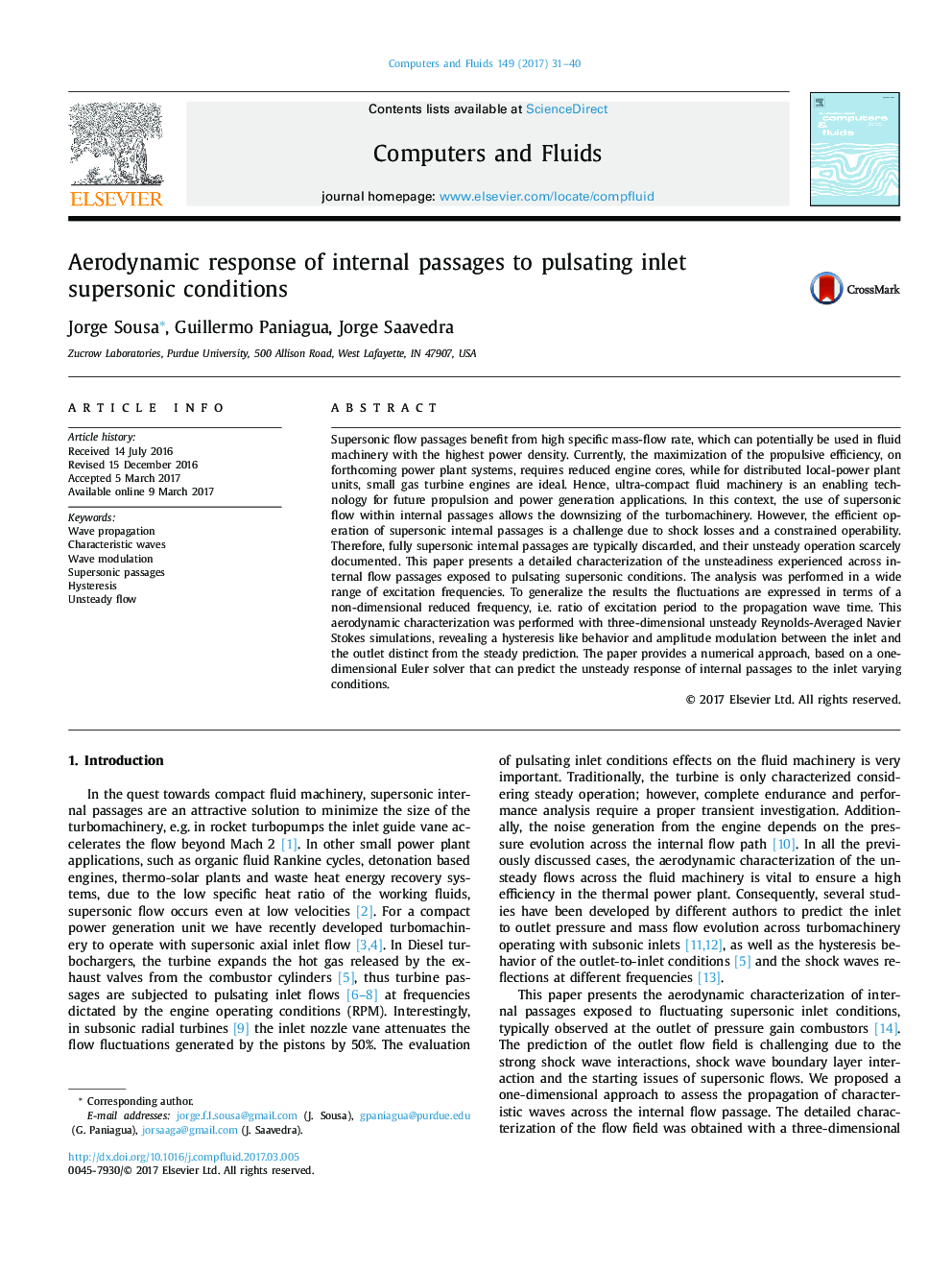| کد مقاله | کد نشریه | سال انتشار | مقاله انگلیسی | نسخه تمام متن |
|---|---|---|---|---|
| 5011880 | 1462662 | 2017 | 10 صفحه PDF | دانلود رایگان |
عنوان انگلیسی مقاله ISI
Aerodynamic response of internal passages to pulsating inlet supersonic conditions
ترجمه فارسی عنوان
پاسخ آیرودینامیک پاساژ های داخلی به ضربان سر و صدا شرایط ورودی فوق العاده
دانلود مقاله + سفارش ترجمه
دانلود مقاله ISI انگلیسی
رایگان برای ایرانیان
کلمات کلیدی
پخش امواج، امواج مشخص، مدولاسیون موج، معابر فوق العاده هیسترزیس، جریان ناپایدار،
ترجمه چکیده
جابه جایی جریان فوق العاده موجب افزایش جریان جرمی ویژه می شود که به طور بالقوه می تواند در ماشین آلات مایع با بیشترین تراکم قدرت مورد استفاده قرار گیرد. در حال حاضر حداکثر بهره وری حرکتی در سیستم های نیروگاه آینده، نیاز به کاهش هسته موتور، در حالی که برای واحدهای توزیع محلی نیروگاه، موتورهای توربین گاز کوچک ایده آل است. از این رو، ماشین آلات مایع فوق فشرده، یک فناوری توانمند برای کاربردهای نیروی محرکه آینده و تولید انرژی است. در این زمینه، استفاده از جریان ابررسانا در عبور از داخل باعث کاهش تراکم توربین می شود. با این حال، کارایی کارآیی گذرهای داخلی صوت، یک چالش است به علت تلفات شوک و قابلیت کارکرد محدود. بنابراین، به طور کامل عبور از درون منظومه شمسی به طور معمول از بین می رود، و عملیات ناپایدار آنها به سختی مستند است. در این مقاله مشخصات مشخصی از عدم اطمینان در جریان عبور جریان داخلی در معرض شرایط خلقی فوق العاده شبیه سازی قرار می گیرد. تجزیه و تحلیل در طیف گسترده ای از فرکانس های تحریک انجام شد. برای به طور کلی نتایج، نوسانات به صورت یک فرکانس کاهش غیرمستقیم بیان می شود، یعنی نسبت دوره ی تحریک به زمان موج انتشار. این مشخصه آیرودینامیکی با شبیه سازی سه بعدی ناپایدار رینولدز-مقادیر ناوی استوکس انجام شد، که رفتار هیسترزیس و مدولاسیون دامنه بین ورودی و خروجی را مشخص از پیش بینی ثابت نشان داد. این مقاله یک رویکرد عددی را براساس یک حلال یک بعدی یولر ارائه می دهد که می تواند پاسخ ناپایدار پاساژ های داخلی را به شرایط مختلف ورودی پیش بینی کند.
موضوعات مرتبط
مهندسی و علوم پایه
سایر رشته های مهندسی
مکانیک محاسباتی
چکیده انگلیسی
Supersonic flow passages benefit from high specific mass-flow rate, which can potentially be used in fluid machinery with the highest power density. Currently, the maximization of the propulsive efficiency, on forthcoming power plant systems, requires reduced engine cores, while for distributed local-power plant units, small gas turbine engines are ideal. Hence, ultra-compact fluid machinery is an enabling technology for future propulsion and power generation applications. In this context, the use of supersonic flow within internal passages allows the downsizing of the turbomachinery. However, the efficient operation of supersonic internal passages is a challenge due to shock losses and a constrained operability. Therefore, fully supersonic internal passages are typically discarded, and their unsteady operation scarcely documented. This paper presents a detailed characterization of the unsteadiness experienced across internal flow passages exposed to pulsating supersonic conditions. The analysis was performed in a wide range of excitation frequencies. To generalize the results the fluctuations are expressed in terms of a non-dimensional reduced frequency, i.e. ratio of excitation period to the propagation wave time. This aerodynamic characterization was performed with three-dimensional unsteady Reynolds-Averaged Navier Stokes simulations, revealing a hysteresis like behavior and amplitude modulation between the inlet and the outlet distinct from the steady prediction. The paper provides a numerical approach, based on a one-dimensional Euler solver that can predict the unsteady response of internal passages to the inlet varying conditions.
ناشر
Database: Elsevier - ScienceDirect (ساینس دایرکت)
Journal: Computers & Fluids - Volume 149, 13 June 2017, Pages 31-40
Journal: Computers & Fluids - Volume 149, 13 June 2017, Pages 31-40
نویسندگان
Jorge Sousa, Guillermo Paniagua, Jorge Saavedra,
